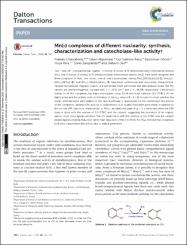Mn(II) complexes of different nuclearity: synthesis, characterization and catecholase-like activity

View/Open
Access
info:eu-repo/semantics/openAccessDate
2016Author
Chakraborty, PrateetiMajumder, Ishani
Banu, Kazi Sabnam
Ghosh, Bipinbihari
Kara, Hülya
Zangrando, Ennio
Das, Debasis
22 readers on Mendeley
Metadata
Show full item recordAbstract
Two "end-off" compartmental ligands, 2-formyl-4-chloro-6-N-ethylmorpholine-iminomethyl-phenol (HL1) and 2-formyl-4-methyl-6-N-ethylpyrrolidine-iminomethyl-phenol (HL2) have been designed and three complexes of Mn(II), one mono-, one di-and a polynuclear, namely Mn(L1)(SCN)(2)(H2O)] (1), [Mn-2(L1)-(OAc)(2)](BPh4)] (2), and [Mn-2(L-2)(OAc)(2)(dca)](n) (3) have been synthesized and structurally characterized. Variable temperature magnetic studies of 2 and 3 have been performed and data analyses reveal that Mn centers are antiferromagnetic coupled with J = -9.15 cm(-1) and J = -46.89, respectively. Catecholase activity of all the complexes has been investigated using 3,5-di-tert-butyl catechol (3,5-DTBC). All are highly active and the activity order on the basis of the k(cat) value is 2 > 1 > 3. In order to unveil whether the metal centered redox participation or the radical pathway is responsible for the catecholase-like activity of the complexes, detailed EPR and cyclic voltammetric (CV) studies have been performed. In addition to the six-line EPR spectrum characteristic to Mn(II), an additional peak at g similar to 2 is observed when the EPR study is done with the mixture of 3,5-DTBC and the catalyst, suggesting the formation of an organic radical, most likely ligand centered. The CV experiment with the mixture of 3,5-DTBC and the catalyst reveals ligand centered reduction rather than reduction of Mn(II) to Mn(I). It is thus inferred that complexes 1-3 show catecholase-like activity due to radical generation.

















